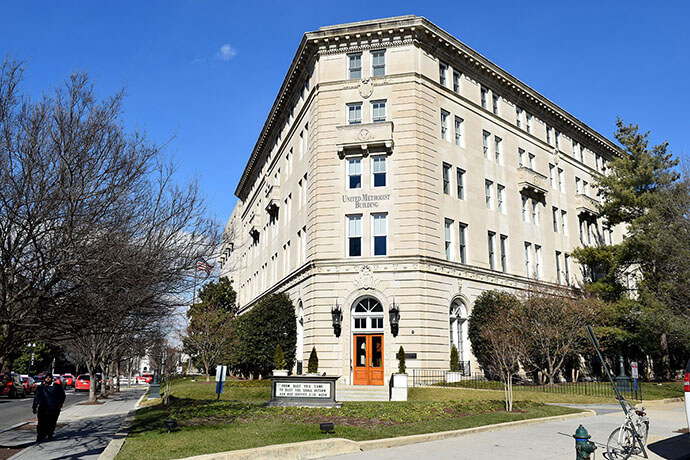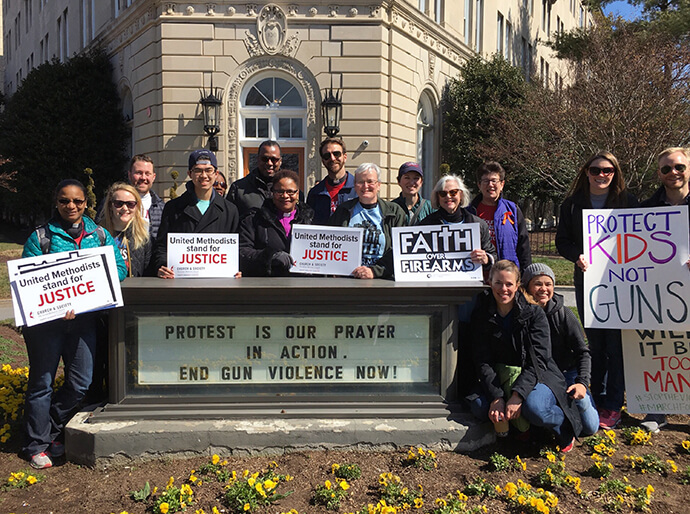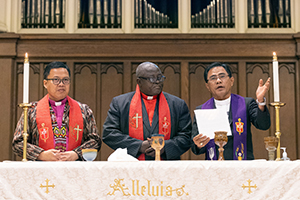Key points:
- John Hill of the United Methodist Board of Church and Society spoke at General Conference May 1 to mark the 100th anniversary of the United Methodist Building in Washington.
- The building was completed in 1923, but General Conference delays because of COVID-19 made this the first time it could be honored at General Conference.
- The building contains conference rooms and apartments rented to United Methodists and people of other faiths, along with offices for nonprofits who fit the Methodist ethos.
During the hurly-burly of General Conference, delegates paused to mark an important United Methodist 100th birthday: that of The United Methodist Building in Washington.
The building, near the offices of the Supreme Court and the U.S. Capitol, was completed in 1923, so it has been there for 101 years. But with General Conference delayed nearly a decade by COVID-19, this year was the first chance to recognize it in that forum.
“Every day, I have the privilege of walking into our offices at The United Methodist Building in Washington, D.C., and am awestruck at the wisdom of our Methodist forebears who positioned this sacred place directly across from the U.S. Capitol — a place set apart for work, worship and witness to the redeeming power and promise of the gospel of Jesus Christ,” said John Hill, interim top executive of the United Methodist Board of Church and Society, at General Conference the afternoon of May 1.
“Today, we invite everyone to learn more about this amazing history on our website or by visiting our booth in the exhibition hall,” Hill said. “And just as importantly, we invite you to join us in continuing this legacy as together we write the next chapter in the powerful story of our Methodist social witness for justice and peace.”

In interviews conducted earlier this year, Hill and two other Church and Society staff members reflected on the building’s storied past and potential for its future.
“Early on, the church saw this opportunity to situate itself between the powers of justice, the powers of law, and to make sure that we have an eye on the goings-on of the U.S. government and its policies on a variety of issues,” said Jessica M. Smith, senior executive director of research, planning and spiritual formation. “I think it's a powerful reminder of the presence of a moral voice speaking out into the public space.”
The United Methodist Building exists because of the foresight of long-ago church leaders, said Smith, author of a book about the building and the work that has been done there, “For Justice and Enduring Peace: One Hundred Years of Social Witness.”
“From the very beginning, the inspiration or vision was to stake our claim in the conversation through this building,” she said.

In addition to the “work, worship and witness” business that happens daily at the building, it also serves as home to some.
“There are some apartments here as well,” Hill said, “so it is, for some folks, a place of residence primarily.”
The building also has a chapel and several conference rooms that can be rented.
“A lot of times, folks need a space when they're doing lobbying visits, to prepare their membership and then come back and report on those visits,” Hill said. “So, the conference rooms are very active both for Church and Society use as well as our ecumenical interfaith and secular partners.”
Other denominations and nonprofit organizations have offices in the building.
“We can provide space for smaller offices, smaller nonprofits, some of whom might have other bigger offices, but then want a presence on Capitol Hill,” Hill said. “Everyone who works here may not be United Methodist, but certainly their mission and work aligns with our Social Principles.”
Added Jeff Corey, director of communications: “We really connect with nonprofits, ecumenical partners and coalition partners who use our space for a variety of workshops and conferences and meetings. It's a very active, vibrant place during the day.”

Perhaps the most visible feature of the building is the marquee near the front entrance of the building. Messages that usually apply to the issues of the day appear there. Examples include: “How long, O Lord, until Congress acts to prevent gun violence,” “From dust you came, to dust you will return,” “The United Methodist Church says torture is wrong” and “No one can serve two masters. You cannot serve God and white supremacy.”
“There's not a science to it,” Hill said. “It is a matter of what's happening in the world, and how our witness might speak into that moment. Sometimes, they're very particular; sometimes, they're a little more seasonal.”
Hill added that Corey is instrumental in crafting the messages, “so it's always a question of both the general secretary's office and communications working to fine-tune that message.”
The sentiments on the marquee are based on the official positions of The United Methodist Church as stated in its Social Principles, Hill said.
“When there are sometimes critique of our position (on the marquee),” he added, “I feel like it's more often a critique of the position of The United Methodist Church.”
Patterson is a UM News reporter in Nashville, Tennessee. Contact him at 615-742-5470 or newsdesk@umcom.org. To read more United Methodist news, subscribe to the free Daily or Weekly Digests.





